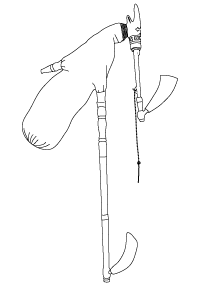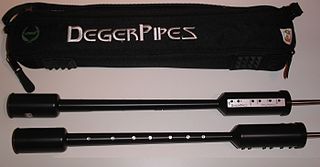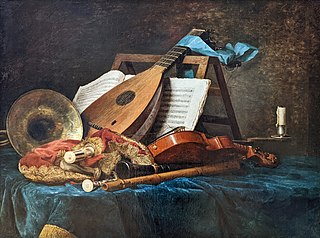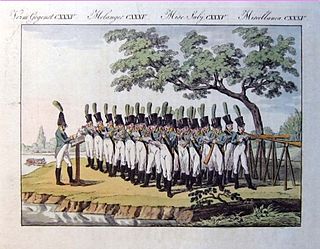Related Research Articles

Bagpipes are a woodwind instrument using enclosed reeds fed from a constant reservoir of air in the form of a bag. The Great Highland bagpipes are well known, but people have played bagpipes for centuries throughout large parts of Europe, Northern Africa, Western Asia, around the Persian Gulf and northern parts of South Asia.

The great Highland bagpipe is a type of bagpipe native to Scotland, and the Scottish analogue to the great Irish warpipes. It has acquired widespread recognition through its usage in the British military and in pipe bands throughout the world.

In traditional Sámi music songs and joiks are important musical expressions of the Sámi people and Sámi languages. The Sámi also use a variety of musical instruments, some unique to the Sámi, some traditional Scandinavian, and some modern introductions.
In Western classical music, obbligato usually describes a musical line that is in some way indispensable in performance. Its opposite is the marking ad libitum. It can also be used, more specifically, to indicate that a passage of music was to be played exactly as written, or only by the specified instrument, without changes or omissions. The word is borrowed from Italian ; the spelling obligato is not acceptable in British English, but it is often used as an alternative spelling in the US. The word can stand on its own, in English, as a noun, or appear as a modifier in a noun phrase.

The Hungarian duda is the traditional bagpipe of Hungary. It is an example of a group of bagpipes called Medio-Carparthian bagpipes.

Welsh bagpipes are a related instrument to one type of bagpipe, a chanter, which when played without the bag and drone is called a pibgorn. The generic term pibau which covers all woodwind instruments is also used in Welsh. They have been played, documented, represented and described in Wales since the fourteenth century. A piper in Welsh is called a pibydd or a pibgodwr.

The Celtic harp is a triangular frame harp traditional to the Celtic nations of northwest Europe. It is known as cláirseach in Irish, clàrsach in Scottish Gaelic, telenn in Breton and telyn in Welsh. In Ireland and Scotland, it was a wire-strung instrument requiring great skill and long practice to play, and was associated with the Gaelic ruling class. It appears on Irish coins, Guinness products, and the coat of arms of the Republic of Ireland, Montserrat, Canada and the United Kingdom.

The torupill is a traditional bagpipe from Estonia.

The pibgorn is a Welsh species of idioglot reed aerophone. The name translates literally as "pipe-horn". It is also historically known as cornicyll and pib-corn. It utilises a single reed, cut from elder or reed, like that found in the drone of a bagpipe, which is an early form of the modern clarinet reed. The single chambered body of the elder pipe has a naturally occurring parallel bore, into which are drilled six small finger-holes and a thumb-hole giving a diatonic compass of an octave. The body of the instrument is traditionally carved from a single piece of wood or bone. Playable, extant historical examples in the Museum of Welsh Life have bodies cut and shaped of elder. Another, unplayable instrument at the Museum, possibly of a later date, is made from the leg bone of an unspecified ungulate. Contemporary instruments are turned and bored from a variety of fruitwoods, or exotic hardwoods; or turned from, or moulded in plastics. The reed is protected by a reed-cap or stock of cow-horn. The bell is shaped from a section of cow-horn which serves to amplify the sound. The pibgorn may be attached to a bag, with the additional possibility of a drone, which is then called pibau cwd; or played directly with the mouth via the reed-cap.

The Swedish cowhorn is a primitive musical instrument constructed from the natural horn of livestock. The instrument has no separate mouthpiece and is blown similarly to a trumpet but with much greater force. There are two types of traditional cowhorns: one without finger holes for scaring off bears and wolves while herding livestock in the forest ("tuthorn") and one with three or four finger holes for calling the domestic animals or other people ("vallhorn"). The cowhorn was used in the Swedish transhumance or fäbodkultur, an ancient system of moving the cattle to remote summer pastures, thus making more efficient use of scarce resources. This was mostly women's work, which is why women excelled at cowhorn playing. Different melodies carried different meanings such as "one of my cows is missing" or "stop looking, your cow is here". Cows, sheep and goats would have each their own melody which made them come back from their foraging. Cowhorns were also played for entertainment, for dancing or for devotions. A testimony of its long-standing tradition, the oldest extant Swedish cowhorn with finger holes dates to the 6th century.

The electronic bagpipes is an electronic musical instrument emulating the tone and/or playing style of the bagpipes. Most electronic bagpipe emulators feature a simulated chanter, which is used to play the melody. Some models also produce a harmonizing drone(s). Some variants employ a simulated bag, wherein the player's pressure on the bag activates a switch maintaining a constant tone. As with other electronic musical instruments, they must be plugged into an instrument amplifier and loudspeaker to hear the sound. Some electronic bagpipes are MIDI controllers that can be plugged into a synth module to create synthesized or sampled bagpipe sounds.
The chromatic trumpet of Western tradition is a fairly recent invention, but primitive trumpets of one form or another have been in existence for millennia; some of the predecessors of the modern instrument are now known to date back to the Neolithic era. The earliest of these primordial trumpets were adapted from animal horns and sea shells, and were common throughout Europe, Africa, India and, to a lesser extent, the Middle East. Primitive trumpets eventually found their way to most parts of the globe, though even today indigenous varieties are quite rare in the Americas, the Far East and South-East Asia. Some species of primitive trumpets can still be found in remote places, where they have remained largely untouched by the passage of time.

The blowing horn or winding horn is a sound device that is usually made of or shaped like an animal horn, arranged to blow from a hole in the pointed end of it. This rudimentary device had a variety of functions in many cultures, in most cases reducing its scope to exhibiting, celebratory or group identification purposes. On the other hand, it has kept its function and profile in many cattle raising, agricultural and hunter-gatherer societies.

A musical instrument is a device created or adapted to make musical sounds. In principle, any object that produces sound can be considered a musical instrument—it is through purpose that the object becomes a musical instrument. A person who plays a musical instrument is known as an instrumentalist. The history of musical instruments dates to the beginnings of human culture. Early musical instruments may have been used for rituals, such as a horn to signal success on the hunt, or a drum in a religious ceremony. Cultures eventually developed composition and performance of melodies for entertainment. Musical instruments evolved in step with changing applications and technologies.
It is unclear whether Lincolnshire bagpipes refer to a specific type of pipes native to Lincolnshire, England, or to the popularity of a more general form of pipes in the region. Written records of bagpipes being associated with Lincolnshire date back to 1407, but it is difficult to find certain proof that any regional variation of the bagpipe existed which was peculiar to Lincolnshire. Despite the lack of evidence for a uniquely local instrument, it is clear that the bagpipe was enjoyed by the people of Lincolnshire.
The mashak is a type of bagpipe found in Northern India, Uttarakhand, Sudurpaschim Province of Nepal and parts of Pakistan and Afghanistan. The pipe was associated with weddings and festive occasions. In India it is historically found in Kumaon and Garhwal in Uttarakhand, Rajasthan and Uttar Pradesh. This bagpipe uses single reeds, and can be played either as a drone or as a melody instrument.

Dūdmaišis or Labonoro dūda is a Lithuanian bagpipe with a single chanter and drone. The Lithuanian bagpipe was traditionally played at a variety of events, including May Day festivities, and spring caroling. A 1955 publication by the Lituanus Foundation noted that: "The Labanoro Dūda or Bagpipe was at one time very widely used, though it is almost forgotten."

The keyed bugle is a wide conical bore brass instrument with tone holes operated by keys to alter the pitch and provide a full chromatic scale. It was developed from the bugle around 1800 and was popular in military bands in Europe and the United States in the early 19th century, and in Britain as late as the 1850s.

The Russian horn orchestra flourished as a distinct music genre in 18th and 19th century Russia. It was a coordinated performance using hunting horns known as Rozhoks, each of which could produce only one specific sound.
References
- ↑ The Musical world. J. Alfredo Novello. 1840. pp. 74–. Retrieved 23 April 2011.
- ↑ Ainsworth Rand Spofford; Charles Gibbon (1893). The library of choice literature and encyclopædia of universal authorship ... Gebbie & co. pp. 351–. Retrieved 23 April 2011.
- ↑ David MacRitchie (1884). Ancient and modern Britons: a retrospect. K. Paul, Trench & co. pp. 399–. Retrieved 25 April 2011.
- ↑ Michael Conran (1850). The national music of Ireland: containing the history of the Irish bards, the national melodies, the harp, and other musical instruments of Erin. J. Johnson. pp. 115–. Retrieved 23 April 2011.
- ↑ "Minutes of Meeting, 10 May 1770". Society of Antiquarians. p.311-312. Retrieved 25 October 2023.
- ↑ "Society of Antiquaries Collections Online | SAL/02/011/043". collections.sal.org.uk. Retrieved 2023-10-25.
- ↑ "herde | SAOB" (in Swedish). Retrieved 2023-10-25.